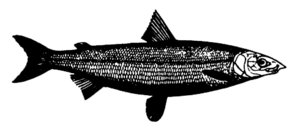Houting facts for kids
Quick facts for kids Houting |
|
|---|---|
 |
|
| Conservation status | |
| Scientific classification |
The houting (Coregonus oxyrinchus) was a type of whitefish. It belonged to the Salmonidae family, which includes salmon and trout. This fish used to live in rivers and estuaries. These waters drained into the North Sea in Europe. Sadly, the houting is now believed to be extinct. This means there are no more of them left.
The houting was special because of its long, pointed snout. It also had a mouth that was on the underside of its head. It lived in countries like Belgium, France, Germany, the Netherlands, and England.
Contents
Is the Houting Really Extinct?
There is a big question about the houting. Some whitefish still live in the southeastern North Sea. These are found near Denmark in the Wadden Sea. People in Denmark call them snæbel. They look very much like the houting. They have the same long, pointed snout and mouth shape. They also live in coastal waters but travel to rivers to breed. This is called being anadromous.
Scientists have studied the Danish snæbel. They found it is related to a common group of whitefish. This group is called the Coregonus lavaretus complex. It is hard to know if the Danish snæbel is exactly the same as the houting that disappeared. This is because there are not enough samples of the extinct houting to compare.
Why the Debate Exists
One main reason for the debate is the number of gill rakers. These are small, comb-like structures inside a fish's gills. They help the fish filter food from the water. The extinct houting seemed to have more gill rakers than the Danish snæbel.
However, the number of gill rakers can change a lot. Even within the same fish species, this number can be different. Some scientists think these differences are not enough to say they are separate species. They believe the houting might not be truly extinct. They think the Danish snæbel could be the same fish.
Conservation Efforts for the Danish Houting
Even with the debate, a lot of effort has gone into saving the Danish houting. From 2005 to 2013, a big project helped protect this fish. The European Union and the Danish Natural Agency helped pay for it. More than €20 million has been spent on its conservation.
Despite these efforts, the main natural population of Danish houting is small. It lives in the Vidå River. In 2014, there were only about 3,500 adult fish. Scientists were worried it might still disappear. However, in 2018–19, the numbers increased to about 4,000 adults. Most of these are in the Vidå River. Some are also found in the Ribe River.
The Danish houting has also been used to bring the fish back to other rivers. These include the Eider and the Elbe rivers. These rivers were once part of the houting's natural home.
See also
 In Spanish: Coregonus oxyrinchus para niños
In Spanish: Coregonus oxyrinchus para niños



